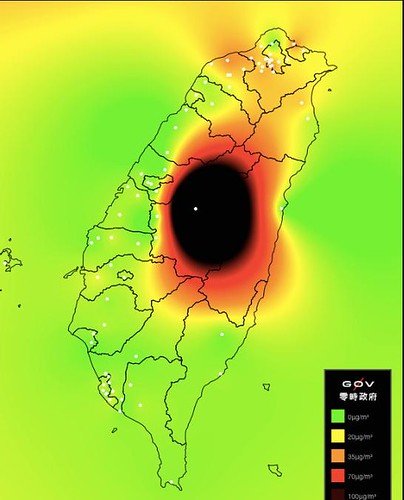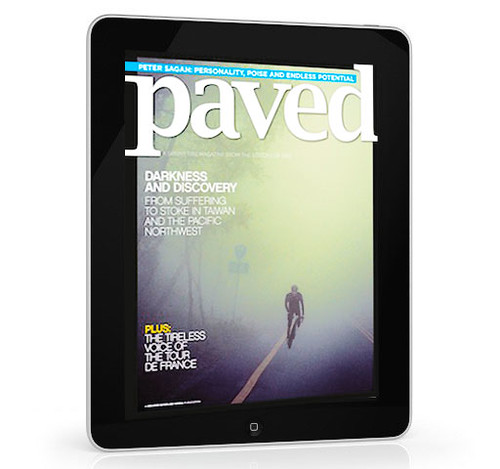
Taiwan Air Quality
This past weekend presented some great riding opportunities. The rain held off long enough for some people to brave Taiwan's notoriously unpredictable traffic. But maybe the wet roads and automobiles will not be what eventually kills off the Taiwanese cyclist. It may be something even more insidious and unavoidable. We may be felled by the air we breathe.
Over the weekend the pollutants on the 2.5 PM scale, or particles under 2.5 million micrometers in size, reached unhealthy levels measuring 154 micrograms per cubic meter or air from Taichung through Miaoli County. Later in the day the index in the Puli basin peaked well above 350mcg/m3. This is not and will not be the first time.
According to the Taiwan Healthy Air Alliance, the poorest air quality can be found in Yunlin's Mailiao Township, and in Nantou County's Puli Township. This is mostly due to the coal-fire power plant and the massive Formosa Plastics complex in Mailiao and Puli's natural basin trapping the air from the Nantou industrial area and the Dalin coal-fired power plant. With Puli being the gateway to Sun Moon Lake and several major tourist attractions and national parks, the government has been slow to take action.

Taiwan Air Quality 4/18/2015
Taiwan's air pollution is not merely the problem of individual localities and townships. This is a tragedy of commons.
1. Taiwan can partially blame the poor air quality on the winter monsoon that sweeps China's industrial and natural air pollution across Taiwan during the winter months. In recent years deforestation and environmental degradation in western China has led to an increase in seasonal sand storms that blow across Asia from the Gobi Desert.
2. China can not be blamed for all of Taiwan's poor air quality. Taiwan draws much of its electrical power from six coal-fired power plants. Taichung's coal-fired power plant is the largest in the world and the world's largest single source of carbon-dioxide emissions with over 40million tons of CO2 emissions annually (more than the entire nation of Sweden emits annually). Five of the six coal-fired power plants are located along Taiwan's densely populated western plain shifting the dispersal of emissions lengthwise over most of Taiwan's population. The sixth is located in Hualien, one of the mainstays of Taiwan's eco-tourism push.
3. Traffic emissions have gotten worse as more Taiwanese take to the roads on weekdays in order to arrive at their jobs that are moving further away from affordable housing on a Taiwanese salary.
4. Another major source of Taiwan's air pollution is, in part, natural. Taiwan's soil is mostly loose clay pushed out of the seabed and as a narrow, steep island, Taiwan fails to retain much of its water runoff, leaving vast, dry stream beds. During periods of high winds, fine particles of dust billow up out of the dry stream beds and fill the air with dust. This is a phenomenon that had been observed as early as the 19th Century, so it is not the result of more recent industrialization.
Still, I say the phenomenon is "in part" natural, as manmade factors also help to contribute to the problem. Like many other places worldwide, human initiated climate change has resulted in the increasing severity of seasonal drought with development and deforestation leading to greater erosion on hillsides and riverbeds leaving more land exposed to high winds. Moreover, much of Taiwan's topsoil is contaminated from agricultural and industrial toxins that can become airborne with loose soil. Heavy metals such as mercury, cadmium, and lead can be blown from the soil to mix with carbon-dioxide, carbon-monoxide, nitrogen-oxide sulphur-dioxide...the last three being the major pollutants from cement manufacturing... a mainstay in Taiwan's ubiquitous construction industrial complex.
It is not difficult to see why this writer is incredulous in the face of vast government expenditures on leisure cycling when the government's plans will only encourage residents to go from the basketball court, swimming pool or badminton court to a bicycle lane. A leisure cycling path does little to curb emissions from where they are generated. It is simply politicians playing the all too cynical game of Three Card Monte with public funds.
Do the positives of cycling outweigh the negatives of breathing pollution?
...as it turns out, face another peril: pollution. New research has found that bicycle commuters inhale twice the amount of black carbon particles as pedestrians. Inhalation of such gunk (aka soot) is associated with reduced lung function and even heart attacks.So, as cyclists in Taiwan where do we go?
The researchers, led by Professor Jonathan Grigg from Barts and the London School of Medicine, compared carbon levels in the lungs of five healthy bicycle commuters those of five healthy pedestrian commuters. The bicyclists had 2.3 times more of the bad stuff in their lungs. Presumably, the cyclists' heavy breathing -- all that good aerobic stuff -- is responsible for the increased presence of black carbon.
1. Taiwan could be entirely run on renewables. We have the engineering and infrastructure available to devote toward energy independence without the nuclear option. We do not have the political will to challenge Tai-Power. Renewables do not have the same patronage potential of the massive, centralized "power plant" that requires mountains of concrete and billions of dollars of rigged bids. One friend who worked for the Number 4 Nuclear Power Plant has confided that it was impossible to work on the facility without being compromised by corruption. Thus, he quit. Wind farms and solar arrays do not provide the "necessary" structural requirements that conceal the flow of expenditures.
2. Taiwan needs to cooperate with other Asian nations to find multilateral support to help curb Chinese pollution in general. Moreover, Taiwanese companies need to avoid using China as a toxic dump by proxy as Taiwanese firms have invested in Chinese manufacturing, the pollution is coming home to roost.
3. Higher wages, lower housing prices, better integration between pedestrian, bicycle and mass transit including urban bike lanes and bike racks on busses would be a great start for the commute.
4. Increased efforts to both clean and eliminate industrial waste in the soil would be a great start.
As we saw with the Kuokuang Petrochemical Complex in Changhua, awareness and activism can, sometimes, beat corporate interests and Taiwan's colonial economy.
Until some major changes are implemented, we, as cyclists in Taiwan, must head out onto the roads with the understanding that we are being poisoned.
Taiwan will not be able to tout its bicycle tourism until Taiwan is finally breathable.
Appendix:
Taiwan Air Pollution Index: Real Time Tracking
Monitor Air Pollution app
Taiwan's Air Pollution Rank Worldwide






























